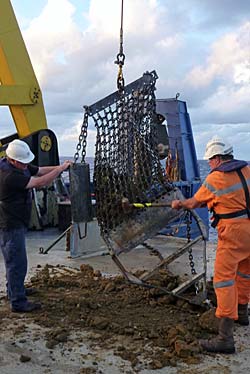gCaptain -
“The data collected on the voyage could significantly change our understanding of the way in which India, Australia and Antarctica broke off from Gondwana,” said Dr Joanne Whittaker, a postdoctoral fellow at the University of Sydney’s School of Geosciences.
Researchers from the University of Sydney, Macquarie University and the University of Tasmania led an international team of scientists on the voyage to map the seafloor of the Perth Abyssal Plain.
The expedition returned to Perth last week after a three-week cruise. Traveling on the CSIRO vessel Southern Surveyor the scientists discovered the islands through detailed seafloor mapping and by dredging rock samples from the steep slopes of the two islands, now in water depths of over 1.5km.
“The sunken islands charted during the expedition have flat tops, which indicates they were once at sea level before being gradually submerged,” said Dr Whittaker.
Collecting rocks from the abyss more than 1.5km below the surface was not easy, but the geologists managed to retrieve hundreds of kilograms and unexpectedly found rocks that showed the islands had not always been underwater.
The University of Sydney’s Dr Simon Williams, the chief scientist on the expedition said: “We expected to see common oceanic rocks such as basalt in the dredge, but were surprised to see continental rocks such as granite, gneiss and sandstone containing fossils.”
In the Cretaceous period when dinosaurs roamed the Earth (more than 130 million years ago), India was adjacent to Western Australia.
When India began to break away from Australia, the islands formed part of the last link between the two continents.

Posted via http://maritime-news.posterous.com Maritime-News posterous
.jpg)
No comments:
Post a Comment